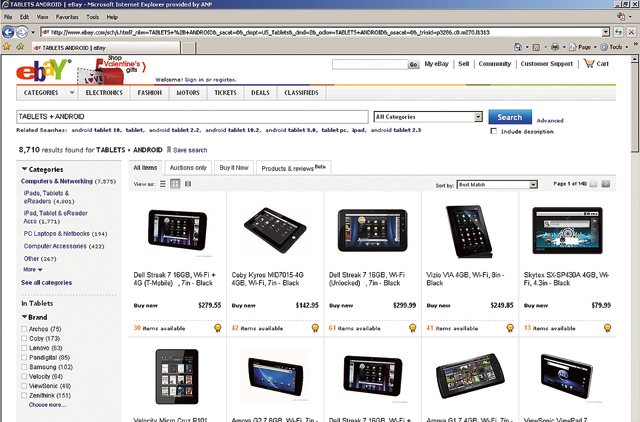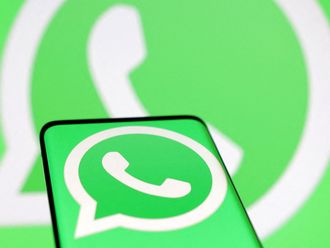
A friend recently came across an irresistible offer on eBay: an Android tablet ePad with LCD touch screen, Wi-Fi and 3G support — including a power charger, USB cable and user manual for only $99 (about Dh363), ready to be delivered directly home free of charge within 14 business days.
Ignoring the alarm bells that rang in his head on sniffing a deal that sounded too good to be true, he placed an order, waiting impatiently for the package to arrive.
I met him after he received his shipment, a bleak expression on his face, tapping spiritlessly on the blurry screen of a bulky black device — his new tablet.
It turned out the piece was sent from a vendor in Hong Kong with a post box address. The user manual did not mention the manufacturer's website, and the company's name was written in Chinese letters. To make matters worse, he had overlooked the remark "returns: not accepted" on eBay. It was a mistake that cost $99.
According to brand protection company MarkMonitor, which released a report last November on the growing trend of fake tablets flooding internet auction websites, the number of cloned or counterfeit tablets has risen considerably.
After just a day of research, brand experts localised 23,000 clones and suspected fakes on more than 20 e-commerce websites. MarkMonitor identified 15 manufacturers of cloned tablets and almost 8,000 individual sellers, including 766 selling bulk quantities of suspected counterfeit tablets.
"Online brandjackers pay close attention to market trends, especially those involving well-known brands, and are quick to put those trends and brand names to their own use," said Frederick Felman, Chief Marketing Officer, MarkMonitor, in a press statement after the study was released. "Consumers should beware these ‘brand impersonators' that are hidden in plain sight, while brands need to be extra vigilant in foiling those who seek to profit at their expense."
Scamming tactics
Cloned tablets are often listed alongside branded goods on the web and even presented in street shops together with the originals. Other common tactics include using photos of branded goods in listings without mentioning the brand and, in some instances, blurring the brand names in photos.
The United Nations Office on Drugs and Crime (UNODC) identified the origin of electronic counterfeit products in its latest study on the issue, released in 2010, with the majority coming in from China, followed by Taiwan, Turkey, Syria, Hong Kong, Myanmar and Indonesia.
In China, UNODC zoned in on a major production region in Guangdong specialising in electronic fake products, which later find their way into global export markets. The UN office also states that many counterfeit goods often transit free trade zones in the Middle East on their way to the West, where unbranded goods are decorated with appropriate logos before being shipped to their destination markets. The shipment of counterfeit products also often includes Chinese commercial distribution companies in the destination country.
Imitating icons
It's no surprise that offers for fake and counterfeit tablet computers spread across the internet after the release of Apple's iconic tablet, the iPad.
According to OpSec Security, a US-based provider of anti-counterfeit technology, it is among the most copied in this market segment, followed by Samsung's Galaxy Tab, Motorola's Xoom and Sony's Tablet S, apart from a wide range of Android tablets. "Whether it's through clever manipulation of photos on auction sites or simply a ‘too-good-to-be-true' bargain, many consumers may fall prey to these scammers if not properly educated," Tom Taylor, president of brand protection for OpSec Security, said in a statement upon the release of a study on counterfeit tablets on January 15, 2012.
MarkMonitor found out that around 20 per cent of copycat manufacturers use original brand names for their fake products and list their items right next to the original devices on e-business websites.
Buyer's guide: How to spot a fake
Here is a list of pointers that should raise alarm bells when you buy a tablet:
• The price looks too good to be true: OK, the price might be good, but the product is not. Beware of deep discounts. A discount of more than 20 per cent on an allegedly original item indicates that it is most likely a fake. However, this does not mean that items priced higher than normal are guaranteed originals. Some fake products are priced at a premium of between 15 to 50 per cent on the manufacturer's suggested retail price in regions where the genuine product is not yet available.
• There is no return or refund policy: Some fake sellers also try to lure buyers by not charging duty and/or shipping costs for the products.
• A poor user manual, soft or hard copy: Examine the manual for the manufacturer's name, website and any related information and warranty policy. Watch for misspellings or poor English on the website or in the printed manual.
• The seller is unknown: If buying online, do a combined search with the vendor's name and the word ‘scam,' for example, and see what comes up.
• The seller is not authorised: If the product seems OK, but you are still unsure, check the manufacturer's website for authorised retail partners/online sellers.
• The model number looks strange: Find out whether the model number of the tablet is legitimate. Some vendors slightly change the model number of an item; for example the Nokia E70 instead of the original E7.
• The images look strange: When buying online, check whether the images of the device look real in terms of actual features, size and colours. When buying from a shop check the box in which the item is sold for irregularities, shoddy wrapping or faulty printing.
• There is no official receipt: Always ask for a stamped receipt. This increases the chance of getting your money back if you have been conned — if necessary with the help of authorities.
— A.M.











